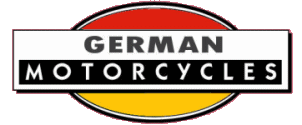


A Brief History of the Marque
Manufactured: Suhl, Germany, 1919-1932
Motorfahrzeugbau Gebr. Krieger, Suhl/ Thüringen, 1919-1932
Cito-Werke AG, Suhl und Köln, 1922-1927
Paul Henkel, Fahrradbau, Mäbendorf/ Suhl, 1927-1932
Motocicletas Krieger Gnädig (1919-1932)
Krieger-Gnädig, a menudo abreviado como KG es una histórica marca de motocicletas alemana fundada por los hermanos Karl, Oskar, Max y Peter Krieger. Los primeros tres de ellos eran excelentes técnicos y Peter era un hábil comerciante.
En los años previos a la Primera Guerra Mundial comenzaron a experimentar con la construcción de aviones y tuvieron bastante éxito. Lamentablemente Karl perdió la vida durante un vuelo de prueba al final de la guerra. Finalizada la contienda y puesto que los aviones no tenían mucha demanda, los hermanos restantes decidieron poner sus esfuerzos en el diseño de una motocicleta innovadora.
Se unieron con el diseñador Franz Gnädig y compraron una fábrica en Suhl en diciembre de 1919. Contrataron personal y desarrollaron los planes para la primera serie de seis modelos de prueba. Estas motos fueron equipadas con válvulas de admisión a la cabeza y válvulas de escape laterales y estuvieron listas para abril de 1920.
El diseño definitivo tuvo un motor completamente OHV (80 x 99 mm) y fue la primera motocicleta alemana con transmisión por cardán (varios años antes que BMW). Otros puntos modernos a destacar fueron el sistema de lubricación por cárter seco, la construcción de un cuadro triangular muy rígido y las ruedas rápidamente desmontables e intercambiables. La caja de cambios de 3 velocidades fue colocada en línea con el motor.
La primera serie tenía pistones de hierro y eran capaces de alcanzar 75 km/h a 3000 rpm. Las series posteriores llevaban pistones de aluminio y podían funcionar de manera segura a 4300 rpm.
Las Kriegers resultaron muy exitosas en las carreras y en pruebas de regularidad. En 1921 tuvieron 22 victorias y alcanzan la producción de la máquina número cien.
Sin embargo, la fabricación de la innovadora y lujosa KG resultó ser muy cara y la fábrica pronto se vio en problemas financieros. En 1922 la fábrica de motocicletas y bicicletas Cito de Colonia se hizo cargo de la producción, pero debido a la inflación y de la aparición de cientos de pequeñas marcas alemanas pronto también Cito estuvo en problemas y fue absorbida en 1923 por la Köln-Lindenthaler Metall Werke (Allright).
Así fue que durante los años siguientes varias fábricas intentaron producir y comercializar el diseño: Allright-KG, Cito-KG, Original-Krieger, Gnädig y Henkel KG fueron los nombres con los que en los años veinte y principios de los años treinta se produjo el diseño, aunque siempre en pequeñas cantidades hasta su desaparición en 1932.
The Krieger brothers - Karl, Oskar, Max and Peter - were natives of Berlin who became quite adept at the the art of aviation during the pioneering days. Karl's employer, Kaiser Willhem II, donated an engine for his first aeroplane, and in 1911 Karl received pilot's licence number 113. 1 Like motorcycling, flying has its dangers, and Karl was killed on a test flight during the latter years of the Great War. 2
The aviation industry subsided considerably subsequent to the armistice and the remaining three brothers turned their talents to motorcycling, a not uncommon occurrence. The links between aviation and motorcycling are substantial, as the two endeavours have common themes - a love of sport, speed, danger perhaps; similar skills of balance, speed and distance judgement; and a keen interest in mechanics.
Technical designer Franz Gnädig joined the business and a factory was established in Suhl in December 1919, development began on several (perhaps six) prototypes, and the first of these saw light in April 1920. (3) These early machines had engines with overhead inlet valves and side valve exhaust (IOE), but production models had 80x99mm OHV dry sump engines, robust triangulated frames, QD interchangeable wheels driven via a 3 speed gearbox and shaft drive. They were the first German machines with a cardan system.
Early models had cast iron pistons and were capable of 3000 rpm, soon replaced with aluminium alloy pistons good for 4,300 rpm.
By June 1921 they had produced one hundred motorcycles, and competition success was accumulating in both road racing and reliability trials.
The early twenties in Germany were years of economic chaos, and demand for expensive toys like the quite brilliant K-G slowed. The firm was in trouble, and in 1922 the factory was absorbed by Cito of Cologne which built the Cito-K.G. Cito in turn was acquired by Allright in 1923, but the writing was on the wall when BMW released its first machines shortly thereafter, and the Allright-KG was dropped from the catalog. Production of the KG continued at the Henkel factory until 1932.
The design also appeared as the Blackburne-engined Original-Krieger (Krieger brothers, 1925), and Gnädig (1924). Gnädig joined Diamant in 1926 and later moved to Opel.
Sources: Yesterdays NL, moto-collection.org, archive-in-thueringen.de, Sergio Scalerandi, GTU Oldtimerservice
Notes
1. Ewald Dähn "die Motorräder aus Suhl"
2. Die Alten Adler, SUPF Bd 2, crash occurred 30/08/18.
3. Source required.
If you have a query or information about Krieger-Gnadig please contact us